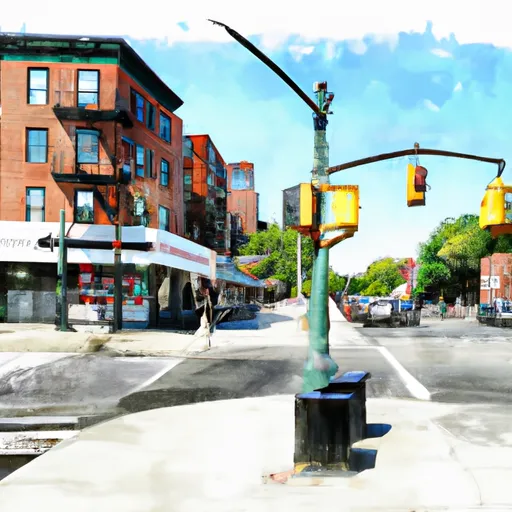-
 Snoflo Premium
Snoflo Premium
Get unlimited access to all our content
With no Ad interruptions! - Start Your Free Trial Login with existing account
Brooklyn
Eden Index
Climate
9.7
•
Recreation
5.6
•
Community
4.9
•
Safeguard
7.1/10

Brooklyn is a borough in New York City with a humid subtropical climate. Summers are warm and humid, while winters are cold and damp. As a coastal city, Brooklyn is prone to flooding and sea level rise due to its hydrology constituents. Outdoor recreation opportunities in Brooklyn include visiting Prospect Park, Brooklyn Bridge Park, and Coney Island Beach. Prospect Park is a 585-acre park with a lake, trails, and a zoo. Brooklyn Bridge Park has a 1.3-mile waterfront promenade with stunning views of the Manhattan skyline. Coney Island Beach is a popular destination for swimming, sunbathing, and amusement park rides.
What is the Eden Index?
The Snoflo Eden Index serves as a comprehensive rating system for regions, evaluating their desirability through a holistic assessment of climate health, outdoor recreation opportunities, and natural disaster risk, acknowledging the profound impact of these factors on livability and well-being.
Climate Health Indicator (CHI): 9.7
Brooklyn receives approximately
1207mm of rain per year,
with humidity levels near 72%
and air temperatures averaging around
13°C.
Brooklyn has a plant hardyness factor of
7, meaning
plants and agriculture in this region tend to thrive during the non-winter months.
By considering the ideal temperature range, reliable water supplies, clean air, and stable seasonal rain or snowpacks, the Climate Health Indicator (CHI) underscores the significance of a healthy climate as the foundation for quality living.
A healthy climate is paramount for ensuring a high quality of life and livability in a region, fostering both physical well-being and environmental harmony. This can be characterized by ideal temperatures, reliable access to water supplies, clean air, and consistent seasonal rain or snowpacks.
Weather Forecast
Streamflow Conditions
Long Island
Area Rivers
Long Island
Snowpack Depths
Long Island
Reservoir Storage Capacity
Long Island
Groundwater Levels
Recreational Opportunity Index (ROI): 5.6
The Recreational Opportunity Index (ROI) recognizes the value of outdoor recreational options, such as parks, hiking trails, camping sites, and fishing spots, while acknowledging that climate plays a pivotal role in ensuring the comfort and consistency of these experiences.
Access to outdoor recreational opportunities, encompassing activities such as parks, hiking, camping, and fishing, is crucial for overall well-being, and the climate plays a pivotal role in enabling and enhancing these experiences, ensuring that individuals can engage in nature-based activities comfortably and consistently.
Camping Areas
| Campground | Campsites | Reservations | Toilets | Showers | Elevation |
|---|---|---|---|---|---|
| Earle RV Military | None | 131 ft | |||
| Sandy Hook - Gateway National Rec Area | 20 | 10 ft | |||
| Allaire State Park | 45 | 66 ft | |||
| Round Pond Military | None | 1,108 ft | |||
| Clarence Fahnestock State Park | None | 1,083 ft | |||
| Blue Mountain Reservation | None | 102 ft | |||
| Floyd Bennett Field - Gateway National Rec Area | 38 | 12 ft | |||
| Beaver Pond - Harriman State Park | None | 974 ft | |||
| Croton Point Park | None | 64 ft | |||
| Fort Wadsworth - Gateway National Rec Area | 7 | 90 ft |
Nearby Ski Areas
Catastrophe Safeguard Index (CSI):
The Catastrophe Safeguard Index (CSI) recognizes that natural disaster risk, encompassing floods, fires, hurricanes, and tornadoes, can drastically affect safety and the overall appeal of an area.
The level of natural disaster risk in a region significantly affects safety and the overall livability, with climate change amplifying these risks by potentially increasing the frequency and intensity of events like floods, fires, hurricanes, and tornadoes, thereby posing substantial challenges to community resilience and well-being.
Community Resilience Indicator (CRI): 4.9
The Community Resilience Indicator (CRI) recognizes that education, healthcare, and socioeconomics are crucial to the well-being of a region. The CRI acknowledges the profound impact of these elements on residents' overall quality of life. By evaluating educational resources, healthcare accessibility, and economic inclusivity, the index captures the essential aspects that contribute to a thriving community, fostering resident satisfaction, equity, and social cohesion.

